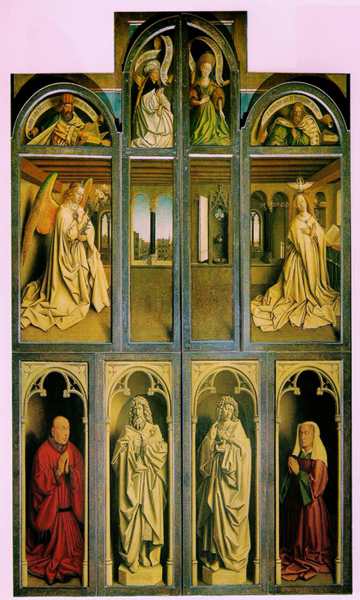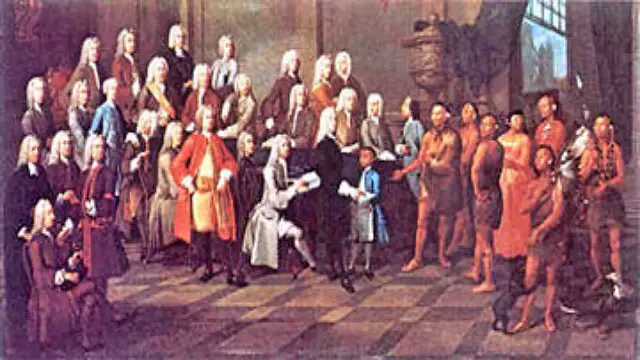The Mystic Lamb
The Ghent Altarpiece, also known as the Adoration of the Mystic Lamb, stands as one of the most significant masterpieces in Western art. Completed in 1432 by the Van Eyck brothers, Hubert and Jan, this polyptych was originally created for the Joost Vijd Chapel in Saint Bavo Cathedral, Ghent, Belgium. Over the centuries, this stunning work of art has captivated viewers with its intricate details and vibrant colors, but it has also been the center of numerous mysteries and controversies.
Key Points
Table of contents
An Artistic Marvel
The Ghent Altarpiece is a complex assembly of 24 scenes, featuring two doors and a central piece that depicts saints and apostles adoring the Mystic Lamb, symbolizing Jesus Christ. The side panels portray pious hermits, pilgrims, Just Judges, and Knights of Christ approaching the central ceremony. The upper register showcases Christ as a King, flanked by the Virgin Mary and John the Baptist, with Adam and Eve at the edges. Angels sing and play music within the vibrant scene.
This oil painting is renowned for its detailed composition, unparalleled realism, mystical significance, and translucent use of color. The luminous quality of the colors has been preserved over the centuries, maintaining its status as a true highlight of Christian art and Western civilization.
The Mysteries Surrounding the Altarpiece
The Ghent Altarpiece has always been shrouded in mystery. During the French Revolution, some panels were taken but eventually returned to Ghent. In 1816, several panels were sold for 100,000 guilders to an antiquary, despite their true value being much higher. These panels were later sold to a museum in Berlin for 400,000 guilders. By the end of the 19th century, these panels had been cut lengthwise. Thanks to the Treaty of Versailles, they returned to Belgium in 1919.
One of the greatest mysteries is the disappearance of the lower left panel, called the Just Judges, which was stolen in 1934 and never recovered. This theft remains Belgium’s most famous unsolved art crime, with countless sleuths still searching for clues.
The Theft of the Just Judges
On the night of April 10, 1934, the Just Judges and St. John the Baptist panels, each measuring 1.49 x 55.5 cm, were stolen from the cathedral. The bishop of Ghent received a letter from a person claiming to have the panels and demanding a ransom of 1 million francs for the Judges, while offering to return St. John for free. The letter was signed “D.U.A.” The authorities only agreed to pay 25,000 francs, and while St. John was returned, the Just Judges panel remained missing.
Arsène Goedertier, a broker from Wetteren, revealed on his deathbed that he had information about the theft. His home contained carbon copies of the ransom notes, but the location of the Judges panel was cryptically described as “in a place where neither I nor anyone else” could retrieve it. Goedertier’s fascination with detective novels, particularly those featuring the character Arsène Lupin, inspired his coded messages in the ransom notes.
Speculations and Theories
Since the theft, many theories have emerged about the whereabouts of the Just Judges panel. Former police chief Karel Mortier dedicated years to searching for the panel within Saint Bavo Cathedral, but x-ray investigations yielded no results. Another theory suggested that the panel was hidden in the coffin of King Albert I, who died in a climbing accident just months before the theft. Maria De Roo, Belgium’s own Miss Marple, claims the authorities already retrieved the panel and concealed its recovery.
Van Eyck’s Alleged Secret Brotherhood
Some believe that the Ghent Altarpiece contains a “Da Vinci Code,” revealing the whereabouts of the Holy Grail or the Holy Bloodline of Christ. Art historian Giorgio Vasari described Jan Van Eyck as an alchemist, hinting at his membership in a secret brotherhood. Modern Freemasons note that Van Eyck’s depiction of Saint Barbara resembles a working lodge.
Van Eyck entered the service of Philip the Good, Duke of Burgundy, in 1425. The Duke moved his court between Brussels, Lille, and Bruges, where Van Eyck resided and died in 1440. While Van Eyck worked on the Ghent Altarpiece, the Duke established the Order of the Golden Fleece, which some speculate had ties to alchemy and secret knowledge.
Nazi Interest in the Altarpiece
The Ghent Altarpiece also attracted the attention of the Nazis. Adolf Hitler, who came to power in 1933, was fascinated by its mystical and heretical connotations. Some believe the Nazis commissioned the theft of the Just Judges panel to incorporate its iconography into their own Aryan religion. During World War II, the SS stole the Ghent Altarpiece and hid it in a salt mine near Salzburg. A special agent was sent to Belgium to locate the missing panel, but the search was unsuccessful.
Conclusion
The Ghent Altarpiece remains a masterpiece of art, shrouded in mystery and intrigue. From its creation by the Van Eyck brothers to the theft of the Just Judges panel, this polyptych has captivated the world with its beauty and secrets. As amateur and professional sleuths continue their search, the allure of the Ghent Altarpiece endures, inviting new generations to unravel its enigmatic history.




















